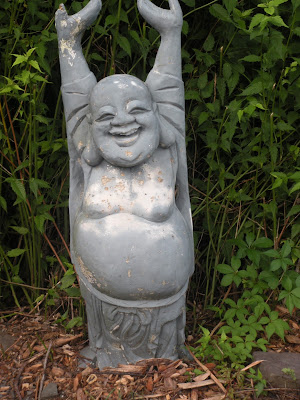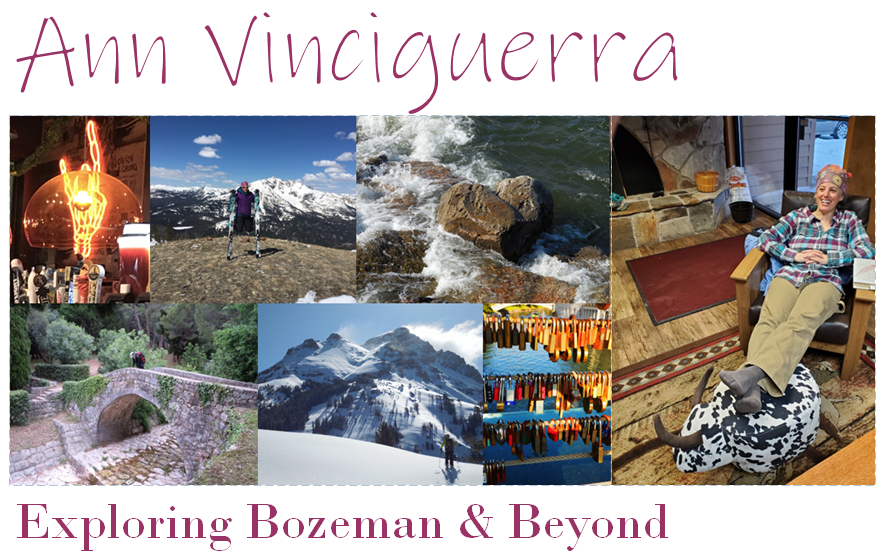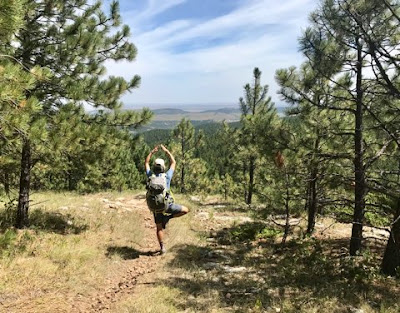The company of inspiring yogis motivated me as I listened to the gentle coaxing of our teacher. “Raise your arms overhead, stretch, and slowly lean back,” he instructed.
As I folded deeper into the pose I felt myself bending, expanding, growing, becoming recharged. Hot yoga was transforming me.
That was not what happened as I worked my way through two months of Bikram yoga classes last spring. While outdoor pursuits are a big part of my life, rainy and muddy spring weather makes the transition between winter and summer activities challenging. To combat this, I looked inside and put myself up for a fitness challenge. Yoga, I determined, would be the activity.
Everyone loves yoga, right? People who do it regularly rave about how it makes them agile and radiant. Perhaps yoga is the missing piece of my fitness routine, something to help improve my alignment and core strength, ultimately helping me with skiing and biking.
I wanted to believe in the possibilities, convinced that if I could squeeze yoga into my packed schedule, I’d become the perfect athlete. I pictured the new luminous Ann who flies up the trail with ease of a mountain lion and glides down the slopes with the grace of an antelope. Muscles lean and taut, joints painless, I’d be a picture of speed, vitality, and elegance.
Yoga should be easy for me. During my younger years I was a competitive gymnast and flexibility came naturally. When my gymnastics days came to an end, I transitioned from being a gymnast and gymnastics instructor who occasionally ran, skied, and went to yoga, and began focusing on outdoor pursuits becoming an avid backcountry skier, mountain biker, and backpacker.
Today, I’m a different athlete with greater stamina, bigger thighs, and broader shoulders. Over time, my flexible body became tighter, and yoga, once an easy and pleasant pastime, turned into a challenge. It had been years since I went to class. Despite my motivation to return to the mat, the prospect was daunting as I worried about how my body react.
Yoga has become so popular in recent years, with instructors and studios popping up all over Bozeman. Some studios add their own distinctive Bozeman touch to yoga, like playing bluegrass or requiring rounds of pushups in-between postures. I don’t care for those liberties and hoped to go a more traditional route in my experiment.
Bikram yoga follows one routine every class. The sessions are held in a 104° F room and are 90 minutes in length, during which time students move through a series of 26 postures and two breathing exercises. Aspiring yogis practice two rounds of each posture and shavasana, or resting pose, is practiced in between each posture during the second half of the practice. The consistency of each Bikram's practice along with regular opportunities to rest made it perfect for my reintroduction to yoga.
~
On my first day of class I placed my mat down, covered it with my lime green Budva beach towel, and sat in the silent studio waiting for class to begin. Around me sat about 20 people of all body types and ages, yet we shared one common characteristic: lack of clothing. Women sat in shorts and sports bras, and men sat topless in baggy shorts.
Between the mirrors on one side of studio and my skimpy outfit, I couldn’t escape my body. I felt 100% exposed, so I kept my mouth shut and avoided eye contact with my classmates. A growing clamminess filled the air. It wasn’t much different than being outside on a hot, muggy day, but with the oppressive heat constrained in the room it felt as if the air was squeezing me from all sides. While my classmates exuded calm, I oscillated between squirminess and listlessness. Anxiety grew, and I dreaded the start of class.
The instructor, a short, compact man with elegant, ropy muscles, strode in and took his spot on a raised platform at the front of the room. Dressed in a pair of ordinary gym shorts he didn’t assume pretenses with designer yoga wear and projected a friendly yet all-business demeanor.
“Raise your arms overhead with intention and grace,” he said.
Easy enough, I thought. We began with a series of standing, bending, and leaning postures, moving our bodies into the shape of a half moon, an eagle, and a triangle. It would have been manageable if it weren’t for the heat. Before long, every part of me was covered in sweat including my inner ears, and I'm pretty certain it was sweat from my ears, not sweat that ran into them.
Class continued, and I grew agitated as I compared myself to others and chastised myself for not measuring up. In one pose we balanced on one leg, me quaking like an aspen tree while beside me a willowy girl with pencil legs was planted solidly like an ancient sequoia. In another pose, we bent back while kneeling. My neck and shoulders crunched as I tipped my head back, and I struggled to reach my hands to my heels, while the blocky guy in the front of the room, who looked as if he spent his days heaving drywall, plopped into a perfect arch.
It pained me to realize that competitiveness, something I thought I gave up when I hung up my leotards, hand grips, and life of a gymnast, was still with me. I was not a picture of intention and grace.
Finally, we moved into our last pose of the practice, shavasana. As I reclined on the wet beach towel covered mat, instead of relief, I felt anxious. I closed my eyes, the lights went out, and eerie silence returned to the room. Physically I was still, but my mind was racing. This was hard, and all I was doing was laying on my back. I was a mess.
In the changing room after class, some women chatted breezily while others seemed transformed and rejuvenated, and I sat there stunned at how hard it was to make it through 90 minutes of bending and folding. Moving slug-like, body tired, I felt as worn out as I would have been after a long day backcountry skiing.
Using what little energy I had, I stripped off my soggy shorts and sports bra, wrapped them in the equally soggy beach towel, and put the lumpy pile in my backpack. It was just sweat, but I was grossed out like a squeamish child. I went home dejected. It was going to be a long two months.
~
Despite my dislike of the heat and lack of skill, I was too stubborn to quit before the membership was up. I had to keep going. The second class wasn't pure torture, but it was far from pleasure.
“Find inner peace and spend time in the present,” our instructor said. “Enjoy the journey.”
I wanted to believe his words, but I was still a long way from acceptance.
Classes moved on and I went twice a week as I promised myself. In one class, during chair pose, I noticed the woman next to me. As we squatted into a seated position and rose onto our toes she started to struggle, and it became a competition, probably in my mind alone, to see who could hold the pose longer. Sweat rolled down my face and I willed my quivering legs to hold me up, but I collapsed while she held on.
 “If you can’t do it,” our instructor said. “Be good with where you’re at today because that’s exactly where you need to be.”
“If you can’t do it,” our instructor said. “Be good with where you’re at today because that’s exactly where you need to be.”
Was he looking at me? I was only a few classes into yoga after a long absence, so I shouldn’t be surprised I was wobbly and tight. Others in class had likely sent time developing these strengths. Why did I hold myself to unrealistic expectations and internally compete with others?
About half way through my challenge, I still felt tight, stiff, and tested, but I could make it through without angst. Although I wasn’t flowing effortlessly, I was staring to enjoy the rhythm of classes. The balance I spent years developing balance as a gymnast and my strong legs from skiing and biking served me well. I told myself to ignore my shoulders and back, which were still tight, and hoped they would loosen with time.
~
After two months and sixteen classed my membership was up. At the end, Birkam yoga was only marginally easier physically, but much easier mentally. I wasn’t transformed, and I wasn’t hooked on yoga, but my experiment produced some unexpected results.
After my yoga challenge, I wasn’t magically stronger, I didn’t develop svelte, gazelle-like legs, and my middle-age muscles still ached after hard days in the mountains. But as I moved from backcountry skiing into summer activities, my body seemed better prepared to use different muscle groups, and I was able to work my way up to longer mountain bike rides and backpacking trips with less soreness and a quicker recovery than I was used to.
Mentally, my focus started becoming stronger. During a late spring ski, my partner Mike and I headed up the Sphinx. The seven-mile approach was long and during the last push to the top I was ready to be done with it. I was sluggish, my legs felt like sacks of cement, and I was not stoked, but I was able to sit with my discomfort and finish with a positive outlook.
Additionally, I developed a stronger sense of determination and a greater willingness to try without being attached to the outcome. When I came to a technical, rocky mountain bike ascent and was forced to walk my bike up the hill, I thought of the words of my teacher and tried to accept where I was at.
On a personal level, patience, which had never been my strong suit, was starting to grow. When a friend showed up at my house to go backcountry skiing, he spewed his gear on the ground, and began assembling his pack before loading it into my car. The new yogi Ann sat calmly and waited.
While I don’t always succeed at maintaining equanimity when I’m outdoors, thanks to my yoga experiment I’m able to catch myself when my thinking becomes negative and now have the tools to help redirect unproductive thoughts and competitive instincts into useful self-motivation. And when I’m less competitive and more accepting of myself and others, outdoor activities become more enjoyable regardless of the outcome.
While I haven’t gone to yoga since my challenged ended, and I’m not sure when I’ll return to the map, the unintended outcomes have helped me develop skills to draw on in outdoor situations and made all of the sweat and discomfort worth it.
~
Another challenge I put myself up to - fasting - http://annvinciguerra.blogspot.com/2019/06/fasting.html



No comments:
Post a Comment